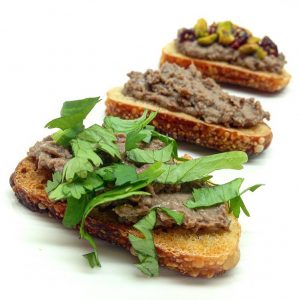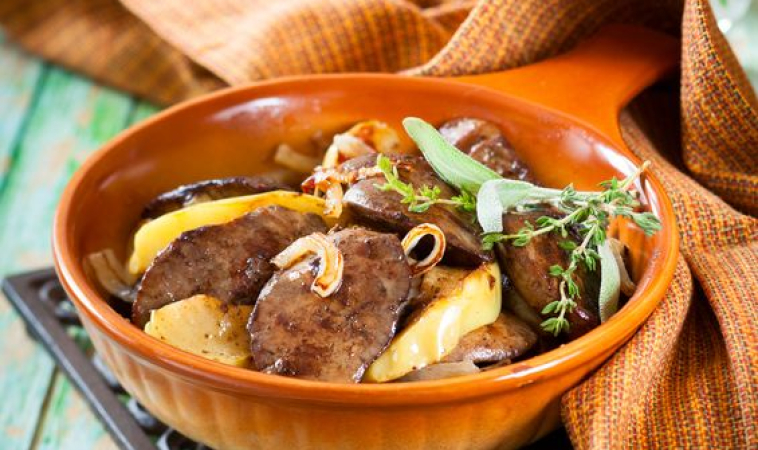Organ Meats: the Original Multivitamins
Inexpensive and nutritious, they were also a staple in the diet of generations past, before nose-to-tail eating became trendy. Organ meats are a much denser source of nutrients than the muscle meats that account for most of our protein intake in the United States. Both are good sources of essential amino acids, but unlike muscle meats, organ meats are richer in omega-3 fats, vitamin D, and coenzyme Q10, a compound used by every cell in the body to generate energy. Organ meats are an especially nutritious food for pregnant women because they are high in purines, which are the building blocks of DNA, as well as folic and choline, which play important roles in brain development and the prevention of birth defects.
According to a 2012 study, choline can induce positive changes in the genetic expression of a fetus affecting the hypothalamic-pituitary-adrenal (HPA) axis, a feedback loop in the body that helps regulate hormone activity and our response to stress.1 Researchers found that women taking a higher dose of choline (930 milligrams) during their third trimester of pregnancy had 33 percent lower levels of cortisol, a stress hormone, compared to women who were taking less (430 milligrams). This is a good outcome because lower levels of stress hormones in pregnant women have been associated with higher IQs in their children.2
Organ meats include the heart, liver, lungs, kidneys, pancreas, brains, and testicles. Sweetbreads refer to the pancreas or thymus gland of a young pig, cow, or lamb. Giblets are the organ meats of birds. The term “offal” refers to the edible parts of animals that are not muscle meat. This includes organs but also the tails, tongue, and feet. Some parts are easier to find than others but chicken livers are widely available and they are the main ingredient in my simple paté recipe below. Always look for organs and offal from pasture-raised and grass-fed animals who have never been exposed to pesticides, hormones, antibiotics, or genetically-modified feed. If your grocery store doesn’t carry them, check your local farmer’s market or order them online.
Quick Chicken Liver Paté
Unlike other kinds of paté, this one can be eaten right away and doesn’t require baking or pressing or curing. You can customize it with any garnish you like. Around the holidays I like to garnish it with dried cranberries or dried tart cherries and pistachios and walnuts. In the spring I top it with baby greens and/or fresh herbs like parsley. For an easy and elegant presentation any time of year, sprinkle some flaky sea salt and drizzle a bit of your best quality olive oil over the top.
Get the best quality chicken livers you can find. If they haven’t already been cleaned, remove any attached ducts, vessels, or other connective tissues. Cut them in half to clean them more thoroughly and reduce the cooking time. I prefer to cook them in rendered chicken fat, but if that isn’t an option, you can substitute ghee or butter.
The velvety texture of this paté pairs perfectly with something crisp like toast. I used sprouted whole grain bread, cut into triangles, but you could make a gluten-free version by substituting a gluten-free bread or cracker. You could make it grain-free by serving it with cucumber or radish rounds. Serve this paté as a starter or a snack, or have it for breakfast.
 Ingredients:
Ingredients:
3 tablespoons rendered chicken fat, divided
1 pound chicken livers, cleaned
Sea salt
1 small onion, thinly sliced
3 cloves garlic, minced
3 tablespoons ruby Port wine
3 tablespoons dry Madeira wine
Ground peppercorn
Sprouted whole grain bread, toasted, to serve
Directions:
- Warm 1 tablespoon of rendered chicken fat in a stainless steel skillet over medium-high heat. Keep the other 2 tablespoons cold in the fridge until you are ready to use them.
- Add the chicken livers and sear until golden brown, about a minute and a half. Flip and brown the other side, about another minute. Do not overcook the livers; they should be slightly pink inside. Remove them from the pan, sprinkle them with sea salt, and set them aside to cool.
- Reduce the heat to medium. Add the onion to the pan and sauté until soft and brown. Take your time with this step to really develop the color and flavor of the onion.
- Reduce the heat to low. Add the garlic and ground pepper. Stir until aromatic, about a minute. Add the Port and Madeira wines. Increase the heat to medium and stir to loosen any bits stuck to the bottom of the pan. Once it starts to bubble, simmer and reduce by half, until the pan juices thicken and there is just enough left to generously coat the livers.
- Return the browned chicken livers to the pan and toss to combine with the onions and sauce. Set the mixture aside to cool completely.
- Once the chicken liver mixture has cooled to room temperature, add it to a food processor along with the remaining two tablespoons of cold rendered chicken fat. Process until completely smooth, then taste for seasoning and make any adjustments. Transfer the paté to a ramekin, small terrine, or other serving dish. Serve it right away, at room temperature, or transfer it to the fridge to chill before serving. Spread the paté onto small toasts and garnish them as you wish or arrange the paté alongside the toasts and garnishes and allow people to do it themselves.
References
1 Jiang X, Yan J, West AA, Perry CA, Malysheva OV, Devapatla S, et al. Maternal choline intake alters the epigenetic state of fetal cortisol-regulating genes in humans. FASEB Journal. 2012;26(8):3563-74.
https://www.ncbi.nlm.nih.gov/pubmed/22549509
2 LeWinn KZ, Stroud LR, Molnar BE, Ware JH, Koenen KC, and Buka SL. Elevated maternal cortisol levels during pregnancy are associated with reduced childhood IQ. International Journal of Epidemiology. 2009;38(6):1700–1710.
https://www.ncbi.nlm.nih.gov/pmc/articles/PMC2786250/
Image Copyright: <a href=’https://www.123rf.com/profile_sarsmis’>sarsmis / 123RF Stock Photo</a>
 Sarah Cimperman, ND is the author of the new book, The Prediabetes Detox: A Whole-Body Program to Balance Your Blood Sugar, Increase Energy, and Reduce Sugar Cravings. She graduated from NCNM in 2002 and has a private practice in New York City. Her expertise has been featured on Fox News and Huffington Post and in Natural Health magazine, Whole Living magazine, and the Well Being Journal, among other publications. Dr. Cimperman also writes two blogs, A Different Kind Of Doctor and The Naturopathic Gourmet.
Sarah Cimperman, ND is the author of the new book, The Prediabetes Detox: A Whole-Body Program to Balance Your Blood Sugar, Increase Energy, and Reduce Sugar Cravings. She graduated from NCNM in 2002 and has a private practice in New York City. Her expertise has been featured on Fox News and Huffington Post and in Natural Health magazine, Whole Living magazine, and the Well Being Journal, among other publications. Dr. Cimperman also writes two blogs, A Different Kind Of Doctor and The Naturopathic Gourmet.

















